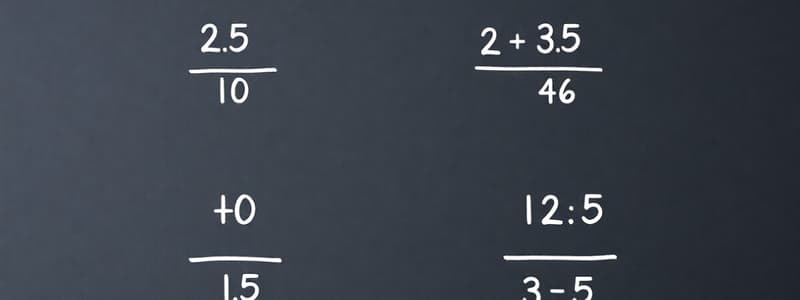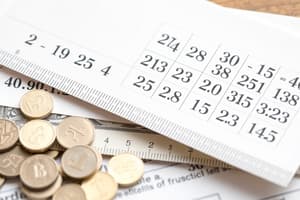Podcast
Questions and Answers
When adding fractions, what must be found first?
When adding fractions, what must be found first?
- The sum of the numerators
- The common denominator (correct)
- The greatest common divisor
- The least common multiple
When subtracting decimals, it is important to align the decimal points.
When subtracting decimals, it is important to align the decimal points.
True (A)
What should you keep the same when subtracting fractions?
What should you keep the same when subtracting fractions?
The common denominator
To add fractions, first find a common ______.
To add fractions, first find a common ______.
Match the operations with their rules regarding fractions and decimals:
Match the operations with their rules regarding fractions and decimals:
Flashcards
Denominator
Denominator
The bottom number of a fraction that indicates the total number of equal parts. For example, in 2/5, the denominator is 5.
Numerator
Numerator
The top number of a fraction that shows the number of parts being considered. For example, in 2/5, the numerator is 2.
Common Denominator
Common Denominator
A number that is shared by two or more numbers. It divides evenly into each number.
Adding Fractions with Common Denominators
Adding Fractions with Common Denominators
Signup and view all the flashcards
Subtracting Fractions with Common Denominators
Subtracting Fractions with Common Denominators
Signup and view all the flashcards
Study Notes
Adding and Subtracting Decimals
- To add or subtract decimals, first align the decimal points in the numbers.
- This ensures that corresponding place values are added or subtracted.
- If necessary, add zeros to the right of the decimal to make the numbers have the same number of decimal places.
- This process is important for ensuring accuracy in calculations.
Finding a Common Denominator
- When adding or subtracting fractions, a common denominator is essential.
- The common denominator should be the smallest number that both denominators divide into without remainder.
- The process often involves finding the least common multiple (LCM) of the denominators.
- Using the common denominator makes it easy to add or subtract the numerators while maintaining a consistent fraction representation.
Adding/Subtracting Fractions
- When adding or subtracting fractions, you must find a common denominator.
- Once you have the common denominator, add or subtract the numerators.
- Keep the common denominator.
- Simplify the resulting fraction, if necessary, by dividing both the numerator and the denominator by their greatest common divisor (GCD).
Decimal Subtraction
- When subtracting decimals, align the decimal points vertically, keeping the same place values aligned.
- This alignment ensures that the digits that represent the same place value are subtracted from each other.
- In cases where a digit in the subtrahend (the number being subtracted) is larger than the corresponding digit in the minuend (the number from which we are subtracting), borrowing becomes necessary.
- This process is part of standard subtraction procedures to maintain accuracy in the final result.
Studying That Suits You
Use AI to generate personalized quizzes and flashcards to suit your learning preferences.




